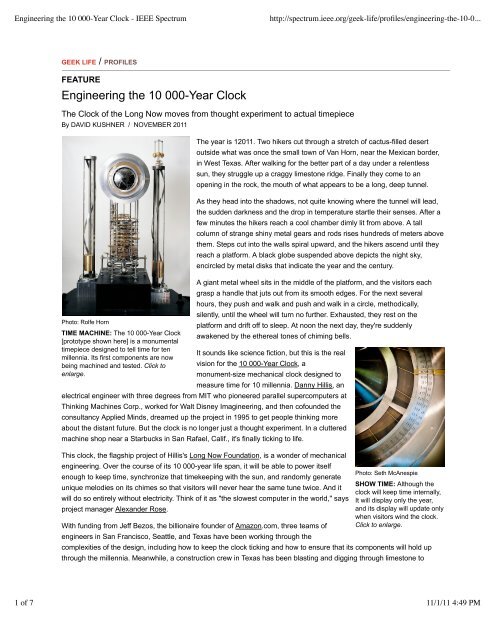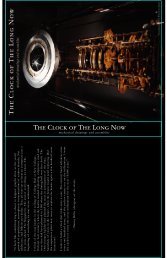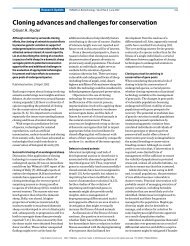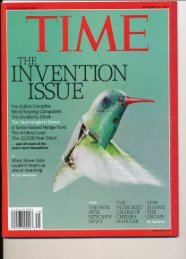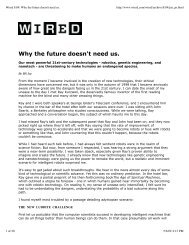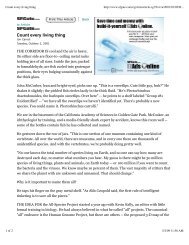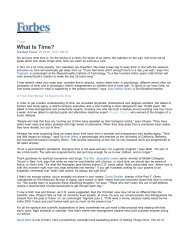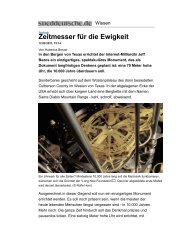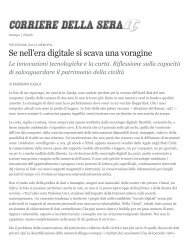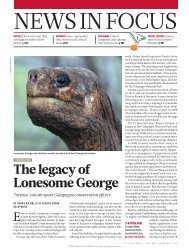PDF Download - Long Now Foundation
PDF Download - Long Now Foundation
PDF Download - Long Now Foundation
You also want an ePaper? Increase the reach of your titles
YUMPU automatically turns print PDFs into web optimized ePapers that Google loves.
Engineering the 10 000-Year Clock - IEEE Spectrum http://spectrum.ieee.org/geek-life/profiles/engineering-the-10-0...<br />
GEEK LIFE / PROFILES<br />
FEATURE<br />
Engineering the 10 000-Year Clock<br />
The Clock of the <strong>Long</strong> <strong>Now</strong> moves from thought experiment to actual timepiece<br />
By DAVID KUSHNER / NOVEMBER 2011<br />
Photo: Rolfe Horn<br />
TIME MACHINE: The 10 000-Year Clock<br />
[prototype shown here] is a monumental<br />
timepiece designed to tell time for ten<br />
millennia. Its first components are now<br />
being machined and tested. Click to<br />
enlarge.<br />
The year is 12011. Two hikers cut through a stretch of cactus-filled desert<br />
outside what was once the small town of Van Horn, near the Mexican border,<br />
in West Texas. After walking for the better part of a day under a relentless<br />
sun, they struggle up a craggy limestone ridge. Finally they come to an<br />
opening in the rock, the mouth of what appears to be a long, deep tunnel.<br />
As they head into the shadows, not quite knowing where the tunnel will lead,<br />
the sudden darkness and the drop in temperature startle their senses. After a<br />
few minutes the hikers reach a cool chamber dimly lit from above. A tall<br />
column of strange shiny metal gears and rods rises hundreds of meters above<br />
them. Steps cut into the walls spiral upward, and the hikers ascend until they<br />
reach a platform. A black globe suspended above depicts the night sky,<br />
encircled by metal disks that indicate the year and the century.<br />
A giant metal wheel sits in the middle of the platform, and the visitors each<br />
grasp a handle that juts out from its smooth edges. For the next several<br />
hours, they push and walk and push and walk in a circle, methodically,<br />
silently, until the wheel will turn no further. Exhausted, they rest on the<br />
platform and drift off to sleep. At noon the next day, they're suddenly<br />
awakened by the ethereal tones of chiming bells.<br />
It sounds like science fiction, but this is the real<br />
vision for the 10 000-Year Clock, a<br />
monument-size mechanical clock designed to<br />
measure time for 10 millennia. Danny Hillis, an<br />
electrical engineer with three degrees from MIT who pioneered parallel supercomputers at<br />
Thinking Machines Corp., worked for Walt Disney Imagineering, and then cofounded the<br />
consultancy Applied Minds, dreamed up the project in 1995 to get people thinking more<br />
about the distant future. But the clock is no longer just a thought experiment. In a cluttered<br />
machine shop near a Starbucks in San Rafael, Calif., it's finally ticking to life.<br />
This clock, the flagship project of Hillis's <strong>Long</strong> <strong>Now</strong> <strong>Foundation</strong>, is a wonder of mechanical<br />
engineering. Over the course of its 10 000-year life span, it will be able to power itself<br />
enough to keep time, synchronize that timekeeping with the sun, and randomly generate<br />
unique melodies on its chimes so that visitors will never hear the same tune twice. And it<br />
will do so entirely without electricity. Think of it as "the slowest computer in the world," says<br />
project manager Alexander Rose.<br />
With funding from Jeff Bezos, the billionaire founder of Amazon.com, three teams of<br />
engineers in San Francisco, Seattle, and Texas have been working through the<br />
Photo: Seth McAnespie<br />
SHOW TIME: Although the<br />
clock will keep time internally,<br />
It will display only the year,<br />
and its display will update only<br />
when visitors wind the clock.<br />
Click to enlarge.<br />
complexities of the design, including how to keep the clock ticking and how to ensure that its components will hold up<br />
through the millennia. Meanwhile, a construction crew in Texas has been blasting and digging through limestone to<br />
1 of 7 11/1/11 4:49 PM
Engineering the 10 000-Year Clock - IEEE Spectrum http://spectrum.ieee.org/geek-life/profiles/engineering-the-10-0...<br />
create the tunnel. In Washington state, engineers at Seattle Solstice are refining a giant stonecutting robot that will<br />
eventually be shipped to Texas and deployed inside the mountain, to etch the spiral staircase directly into the rock. "This<br />
is a project of a bunch of engineers," says Rose. "And building a big physical thing is just cool."<br />
Still, the designers believe there's much more to the project than just geek chic. A clock that's meant to last for 10 000<br />
years poses a fundamental challenge for a speed-obsessed age: How do you engineer something for the very distant<br />
future and get people to care about it today?<br />
Photo: Quinn Norton<br />
TIMEKEEPERS: Parallel computing pioneer Danny Hillis [right] dreamed up the 10 000-Year<br />
Clock as a way to encourage long-range thinking. He and Alexander Rose [left] are now<br />
leading the clock's design and engineering team. "Building a big physical thing is just cool,"<br />
Rose says.<br />
mountain, waking up to the sound of bells.<br />
On a bright blue morning in<br />
February, I drove to the San<br />
Rafael shop with Rose to see<br />
the first assembled piece of the<br />
clock in action: several<br />
2.4-meter-wide gears for the<br />
chime generator, one of the<br />
largest and most complex parts<br />
of the clock. Over the lifetime of<br />
the clock, the chime generator<br />
will ring a series of 10 bells in a<br />
different arrangement each<br />
time.<br />
"I haven't seen it turn on yet,"<br />
says Rose, tall and chrome-<br />
domed, dressed in a black polo<br />
shirt and khaki pants. "Baptism<br />
by fire." He flips a switch, and<br />
he and I watch the giant<br />
stainless-steel gears spin<br />
silently. I picture those future<br />
hikers deep inside the<br />
But what's the point of building something to last 10 000 years? Hillis says he chose that time span because that's about<br />
how long human technology has been around. One inspiration came from a possibly apocryphal tale of a forward-looking<br />
architect. According to the myth, back in 1386, the builder of the University of Oxford's New College planted some oak<br />
trees [<strong>PDF</strong>]. The purpose was to have wood that could be used to replace the oak beams of the college's great dining<br />
hall hundreds of years in the future.<br />
For an engineer who had built his career on making fast machines, Hillis found this story of forethought striking. Living in<br />
an increasingly accelerated culture, he thought, was eroding our ability to think concretely about the future. "Why bother<br />
making plans when everything will change?" he wrote in a 1995 manifesto. Building an ageless clock, Hillis suggested,<br />
was a way to bring really long-term thinking back.<br />
He took his idea to a private mailing list that included future-minded thinkers such as Stewart Brand, founder of the<br />
WELL (the Whole Earth 'Lectronic Link) online community, and electronic musician Brian Eno. The idea captivated the<br />
group, and Hillis began to consider more seriously how his clock might actually get built. In 1997, after starting the <strong>Long</strong><br />
<strong>Now</strong> <strong>Foundation</strong>, he began to work on the clock in earnest with Rose, a Carnegie Mellon–educated industrial designer<br />
whose eclectic résumé includes stints as artist in residence at Silicon Graphics and designer of championship combat<br />
robots.<br />
Like Hillis, Rose saw the urgency of the idea. Society needs to think long term or risk failing to appreciate such century-<br />
2 of 7 11/1/11 4:49 PM
Engineering the 10 000-Year Clock - IEEE Spectrum http://spectrum.ieee.org/geek-life/profiles/engineering-the-10-0...<br />
spanning problems as climate change and deforestation, Rose told me. The basic notion may have been a quick sell,<br />
but actually building the clock, he and Hillis knew, would be immensely difficult. As Hillis wrote in his essay, "My<br />
engineering friends worry about the power source: solar, water, nuclear, geothermal, diffusion, or tidal? My<br />
entrepreneurial friends muse about how to make it financially self-sustaining."<br />
The money turned out to be the easy part, because the clock had attracted a formidable believer: Amazon's Bezos, who<br />
calls himself "the first steward" of the project. Bezos was struck by the clock's big idea. "If you read my 1997 shareholder<br />
letter (<strong>PDF</strong>) [the year Amazon.com went public], it's all about the long term," Bezos tells me. "And so this philosophy, this<br />
ability to use long-term thinking to accomplish important things, is a common thread in everything I'm involved in." This<br />
includes Blue Origin, his private spaceflight company. The clock is being built on a ridge that overlooks Blue Origin's<br />
headquarters.<br />
Bezos, who got his undergraduate degree in electrical engineering and computer science from Princeton, was also<br />
drawn to the project by the sheer geeky quality of the thing. "It's a challenging engineering problem and so fun in its own<br />
right," he says.<br />
Bezos is footing the bill for the clock's installation near the tiny town of Van Horn. Hillis and Rose hope this clock will be<br />
the first of several at different sites. (Small-scale prototypes of the clock already exist, including one that's now housed at<br />
the Science Museum in London.) Although the budget for the Texas project has not been officially disclosed, a recent<br />
article in Wired put it at US $42 million. Given the highly skilled staff, the high-tech construction and machining<br />
equipment, and the rarefied raw materials involved, that seems about right. But Bezos bristles at the notion that his<br />
investment might be perceived as frivolous. "Symbols are important," he says.<br />
Images: <strong>Long</strong> <strong>Now</strong> <strong>Foundation</strong><br />
CHIME TIME: The clock's<br />
digital mechanical computer<br />
[drawing and prototype shown<br />
here] is a complex system of<br />
gears, pins, and rollers that<br />
generates a unique sequence<br />
of chimes each time it's<br />
played. Click to enlarge.<br />
you accept that premise, then<br />
you'll understand why Hillis and Rose's first concern wasn't sketching out the clock's innards. Instead, they obsessed<br />
over how people would experience the clock. They wanted it to be as engaging as possible, "to make someone care<br />
about it in 10 000 years," Hillis says.<br />
"We spent more time debating the aesthetics of a given part and how humans will interact with it than any other thing,"<br />
says Rose. "What is the day like as they walk through this architectural-scale clock mechanism?"<br />
For inspiration, the team looked backward—to enduring ancient monuments like the Egyptian pyramids and<br />
Stonehenge. They also looked to the present—to theme park rides, such as those Hillis designed during his time as vice<br />
president of R&D for Walt Disney Imagineering. They realized that what each of these very different entities has in<br />
3 of 7 11/1/11 4:49 PM<br />
If
Engineering the 10 000-Year Clock - IEEE Spectrum http://spectrum.ieee.org/geek-life/profiles/engineering-the-10-0...<br />
common is that the visitor experiences it as a rite of passage.<br />
Hillis has spent the past seven years working with Rose and other members of the team to design what he calls the<br />
"plotline" of the clock. First, they wanted to ensure that visitors would be vested in the journey. That meant building the<br />
clock in a faraway, hard-to-reach place, somewhere requiring a real commitment to visit. (The site they chose indeed<br />
qualifies—for now. But it's anyone's guess what this place will be like in 10 000 years.)<br />
Even after the intrepid explorers of the future reach the site, the drama of their journey would continue to unfold as they<br />
enter the mountain, snake through tunnels, and climb up the spiral steps past the clock gears. Finally, they would arrive<br />
at the chosen spot, where they would wind the chime generator and hear the bells ring.<br />
But what if you were the first person to visit the clock in centuries, or even millennia? Given the vagaries of human<br />
history, it's reasonable to expect that people might one day forget the clock even exists. So for the sake of the wayward<br />
traveler who just happens upon the clock by accident, the operation had to be obvious just from looking at it.<br />
"Someone who looks at a part must be able to figure out what to do," Rose says. "People need to be able to stumble<br />
across it and understand how it works and how to maintain it." He and Hillis call this quality "transparency."<br />
An electronic clock was therefore out of the question: It wasn't sufficiently transparent. Instead, they decided to make the<br />
clock entirely mechanical—even the digital computer that generates the melody of the clock's 10 chimes. The chime-<br />
generating computer uses a phased series of twenty 2.4-meter-diameter gears, called Geneva wheels, to produce up to<br />
3.5 million unique sequences of chimes.<br />
Although much of the clockwork is similar to the workings of a standard grandfather clock, it differs from an ordinary<br />
analog gear-driven clock in a few key ways. For one thing, it will be the largest clock ever built. And instead of having a<br />
pendulum that counts off each second, the clock's pendulum has a base of 10 seconds. So it will tick at one-tenth the<br />
speed of a regular clock, which should help its gears, bearings, and other components last at least 10 times as long. And<br />
rather than having a 12-hour face, the clock will display the positions of the stars on a black globe, surrounded by dials<br />
showing the year, the positions of the sun and moon, and other astronomical data.<br />
The clock is being designed modularly, so visitors will be able to see how the various parts go together. Working in<br />
modules has the added advantage of letting the engineers tweak different elements of the design without having to start<br />
from scratch each time. They are also discussing the possibility of including some kind of instruction manual, likely in the<br />
form of photographs or diagrams. They haven't yet decided, though, where to put the instructions or even how to alert<br />
people 10 000 years from now that the clock exists.<br />
Once they'd settled on the<br />
narrative arc of the clock<br />
experience, Hillis says, "then<br />
it's just a lot of engineering."<br />
Despite his flip response, the<br />
clock's design has been about<br />
as thoroughly thought out as<br />
that of a Formula One race car.<br />
Hillis and Rose could find no<br />
precedents for what they<br />
wanted to do. "Nothing else is<br />
built to last this long," Rose told<br />
me. He had just returned from<br />
the Svalbard Global Seed<br />
Vault, in Norway, where<br />
millions of seeds from around<br />
4 of 7 11/1/11 4:49 PM
Engineering the 10 000-Year Clock - IEEE Spectrum http://spectrum.ieee.org/geek-life/profiles/engineering-the-10-0...<br />
Photo: Jim Merithew/Wired.com/Condé Nast Publications<br />
HARD TIME: Stuart Kendall of Seattle Solstice designed this stone-cutting robotic arm to<br />
create the spiral steps that will line the limestone walls of the clock chamber.<br />
the world are now being stored<br />
in a remote, highly protected<br />
underground bunker as a<br />
hedge against climate change<br />
and human conflict. Rose also considered the design of nuclear-waste storage facilities, which are built to last for<br />
centuries or longer. But neither of these constructs is a working machine, he explains.<br />
Even seemingly simple questions proved difficult to answer, such as: What should the clock be made of? The team<br />
needed materials that could stand up to thousands of years of wear and tear, yet few studies could shed light on the<br />
matter. For insights, they looked at the 11 000-year-old tower of Jericho, believed to be the oldest existing building in the<br />
world. They discovered that the mortar's high silica content contributed to its longevity. The team is now culling similar<br />
material from a marble mine in Texas.<br />
For the clock's components, the team has been selecting durable materials such as stainless steel, titanium, and<br />
ceramic, whose longevity can be gauged through high-temperature testing. "How they behave at a high temperature is a<br />
good indication of how they will perform over a long period of time," Hillis says.<br />
Consider the chime generator. The gears are made of type 316L stainless steel, a marine-grade alloy that is extremely<br />
resistant to corrosion. "It has been tested in saltwater environments and accelerated aging systems for almost a century<br />
now," explains Rose. "Like all things it will eventually oxidize, but it does so at a known rate that is within our<br />
parameters."<br />
There was a concern, however, that over the centuries the clock's components might weld together if everything were<br />
made from the same material. So most of the pinion gears, as well as the pendulum and encasement, will be made of<br />
titanium. Many of the bearings, meanwhile, will be made from silicon nitride, a ceramic.<br />
The bearings will have unusually rigorous demands placed on them: Although they'll be protected by dust shields, they'll<br />
still have to hold up for 10 million slow speed cycles without lubrication. The closest real-life parallel is the bearings in<br />
satellites, says Rose, and those have only a 20-year operational life. So far, the group's testing shows that the gears<br />
won't gum up from extended use. But 10 000 years is a long time.<br />
"No one has tested them the way we need them tested," Rose says with a sigh. "No one has used titanium against<br />
stainless steel for such long periods of time."<br />
Photos: top, <strong>Long</strong> <strong>Now</strong><br />
<strong>Foundation</strong>; bottom, Steve Hoge<br />
TIME MARCHES ON: To<br />
reach the clock, visitors will<br />
have to walk for the better part<br />
of a day until they arrive at a<br />
150-meter-long tunnel. The<br />
clock will be housed in a tall<br />
vertical chamber at the<br />
5 of 7 11/1/11 4:49 PM
Engineering the 10 000-Year Clock - IEEE Spectrum http://spectrum.ieee.org/geek-life/profiles/engineering-the-10-0...<br />
tunnel's end [model shown<br />
here]. They'll climb the spiral<br />
steps until they reach a<br />
platform, where they'll wind<br />
the clock.<br />
Selecting the right materials is only one piece of the puzzle. There's also the matter of<br />
keeping the clock ticking and telling the correct time. Because, really, what's the point of a<br />
clock if it can't tell time?<br />
To maintain the clock's accuracy, Hillis and Rose had to figure out a way to somehow sync<br />
their clock, buried deep within a mountain, with the outside world. In earlier designs, they considered a solar<br />
synchronizer: A beam of sunlight would pass through a slot in the top of the clock at noon, heating up and contracting a<br />
piece of nickel titanium shape-memory wire; the wire would act as a mechanical trigger, resetting any error that had crept<br />
into the timekeeping since the previous day.<br />
It's a clever idea, one of many the team has devised. In total, they have 10 U.S. patents on the clock, including the<br />
winding tower, the clock face, and the solar-triggering mechanism. "We're probably the only ones patenting weird clock<br />
esoterica," Rose says.<br />
The problem with memory wire, as with the use of electronics, was the lack of transparency. "Nickel titanium can last, but<br />
it's effectively a magic material," Rose says. "It would be difficult to replicate it in the future if someone needed to remake<br />
that part."<br />
Instead, the sun could be exploited in two different ways. "The most promising design we're looking at uses two tanks of<br />
air: one near the surface of the mountain where the sun can heat it up and another that is kept cool inside the mountain,"<br />
says Rose. The difference in temperature, amounting to tens of degrees, causes air to move from the hot tank to the<br />
cool one during the day; when the surface tank cools down at night, the airflow reverses. The movement of air will drive<br />
a piston or a bellows, which will ratchet up the clock's 4.5-metric-ton weights. The weights will then have enough<br />
potential energy to keep the 136-kilogram pendulum swinging for the next day.<br />
To recalibrate the clock, the current plan is to use a titanium box that pops out one normally concave side when the air<br />
inside heats and expands at around solar noon. This will trigger a correction in the pendulum if it's swinging too quickly<br />
or too slowly.<br />
Using these mechanisms, the clock will be able to keep track of the time. But displaying the current time, the team<br />
decided, will require visitors to wind the clock—yet another way to give the visitor's experience meaning. How long you<br />
spend winding the clock will depend on how long it has been since the last person visited: Winding it fully will take three<br />
people about 8 hours. Of course, that's assuming people 10 000 years from now will still be able to perform manual<br />
labor.<br />
The challenge didn't end with<br />
designing the clock. The<br />
question was also where to put<br />
it. The team knew they wanted<br />
somewhere remote, to<br />
enhance the experience and<br />
because cities are so<br />
vulnerable to the ravages of<br />
war. They also figured it<br />
needed to be underground to<br />
have a shot at lasting for<br />
millennia, but not so far down<br />
that it would be below the water<br />
table. This meant putting it<br />
inside a mountain. But what<br />
kind of rock? Granite is difficult<br />
to cut, so they settled on<br />
6 of 7 11/1/11 4:49 PM
Engineering the 10 000-Year Clock - IEEE Spectrum http://spectrum.ieee.org/geek-life/profiles/engineering-the-10-0...<br />
Photo: <strong>Long</strong> <strong>Now</strong> <strong>Foundation</strong><br />
SPACE TIME: The 10 000-Year Clock will reside inside a limestone ridge outside Van Horn,<br />
Texas, on property owned by Amazon.com's Jeff Bezos, overlooking the headquarters of<br />
Bezos' private spaceflight company, Blue Origins.<br />
limestone—soft, but not so soft<br />
as to easily fall apart.<br />
The search was then on for a<br />
dry desert region with<br />
limestone mountains. They needed a cliff that was fracture free, so they could dig the tunnel, and also south facing, for<br />
solar-power generation. Sites from South America to the Middle East were considered. In 1999, the <strong>Long</strong> <strong>Now</strong><br />
<strong>Foundation</strong> purchased some land in eastern Nevada as a possible home for the clock.<br />
Ultimately, though, a patch of land owned by Bezos outside Van Horn, Texas, was chosen for the first clock installation.<br />
The monument will sit between two cliffs on either side of the mountain. With 150 meters of tunnels and shafts to<br />
excavate, the construction crew is using high-precision blasting and robotic mining equipment. Eventually, the clock's<br />
components will be shipped to Texas and reassembled inside the mountain. Although the project was originally slated to<br />
finish in 2001, these days there is no official schedule for completion, and the team estimates at least a few more years<br />
of construction lie ahead before the clock will be completed and opened to the public.<br />
For all the creative deliberation, hard work, and long-term planning, there's one thought that continues to haunt these<br />
engineers. "My biggest fear is that people will destroy it on purpose," Rose says.<br />
To help it survive, the team is making it as tamperproof as possible. Rose compares the overall design to "a ship in a<br />
bottle. Once it's built it will be hard to get it out of the space it's in." They also plan to store spare parts nearby. "We're<br />
building it to withstand being broken," he says. But even a broken clock will change the way people think, Rose adds. He<br />
recalls a recent encounter with a skeptic, who predicted that the machine would eventually be rendered inoperable<br />
"when the blood of future human sacrifices stops up the gears."<br />
"That might be," Rose told the man. "But before you walked into this room, you weren't thinking 3000 years ahead. So<br />
it's already worked. By you and I having this conversation, it achieved its goal—and it's not even built yet."<br />
This article originally appeared in print as "Ticking to Eternity."<br />
About the Author<br />
David Kushner wonders how people will view the clock millennia from now: "I keep picturing the Neanderthals in 2001: A<br />
Space Odyssey discovering the monolith, stumbling on to this amazing thing." A Spectrum contributing editor, Kushner<br />
has written three books, including Levittown: Two Families, One Tycoon, and the Fight for Civil Rights in America's<br />
Legendary Suburb.<br />
Recommend 200 people recommend this.<br />
7 of 7 11/1/11 4:49 PM


